Defensive towers of Cantabria
In Cantabria, there is a big number of fortified towers that fulfilled functions of housing and defense.[1] These buildings, generally battlements, were erected mostly between the 13th and 15th centuries by noble families and influenced significantly in the architecture of Cantabria, passing some to be forts-houses, prelude to the future casona montañesa.[2] A curious fact is that there are not in the region circular towers (except in some churches), as yes happens in the neighboring community of Asturias.[1] Currently of the towers that survives several are in a deplorable condition.
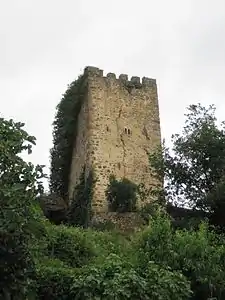
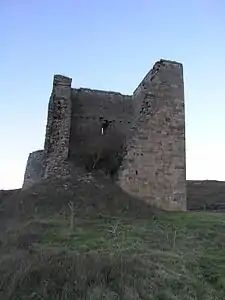
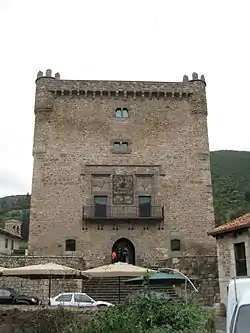
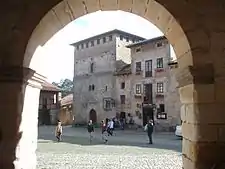
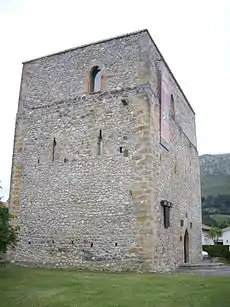
The towers and castles that appear in medieval documents as castellum were very popular both as fortress as residences of nobles, mayors and gentlemen, and eventually generalized in the lower valleys of Cantabria, building on the hills and in the towns; one of the best examples of urban towers resulted in towns is the missing Torre de la Vega genesis of Torrelavega.[3]
The defensive towers of Cantabria, for its architectural features, can only be compared with those of Enkarterri comarca of Biscay surrounding.[1]
Evolution of the Cantabrian towers
Highmedieval fortifications
In the territory currently occupied by Cantabria can distinguish three stages in the medieval military architecture. The first, around the 7th and 12th centuries, is documented with an about twenty of sites that correspond with small castles, presumably linked to respective alfozes, and are the first organization in the Cantabrian territory not monastic nature. These castles are arranged in high places, easily defensible and often visible to each other. At the end of the stage, the new castles, related to the founding of the four villas (Castro Urdiales, Santander, Laredo and San Vicente de la Barquera), there are more complex and are located in the same urban centers. Successively renovated, staged centuries later in the third phase with the walls around the villas[4]
From 13th century, with the gradual increase of feudal power, appear across all Cantabria a large number of towers, more or less fortified, covering the entire territory and still are preserved enough samples. In the late Middle Ages there is only one instance in Cantabria leaking of this type, the Castle of Argüeso.[4]
The medieval tower
On low medieval stage the family fortifications splashed the Cantabrian geography with buildings designed to defend the coast and protection against war of the bands [5] It is isolated towers built between the late 12th century and early 15th, which meet certain military function and watchtower over the territory. Its respond to a style Gothic, in many occasions late, and did not show up in urban centers.
Its have, as common features, square plants and walls of masonry with reinforcements of ashlar, narrow windows and mullioned or ensaetadas, usually a single entry and wood floors. Usually it has three to four floors, being the services in the lower (cellar, salting), a banquet and reception at the first and stately premises on successive; The main staircase was located near the entrance and was usually of wood. Probably each floor was free of divisions, except for the tapestries that hid the stately bed, and found no traces of partitions.[6] Some possessed wall and pit. In some cases virtually all walls are of masonry. The entry was a lowered arch flanked by loopholes; inside, a staircase from beside it two sections per floor attached to front progresses. The overall volume has few voids and creates a heaviness. The decor is virtually nonexistent. Normally its were topped by battlements. Inside an open wall near the window, with a bench, covered by a segmental arch [7]
The inner structure consisted of a central wooden trunk holding a large wooden beam on each floor, from which was forged between it and the stone walls. Only sometimes an inner wall of masonry on which to forge, replacing the wooden pillar.[7]
In some cases, few, these towers were surrounded by a high barbican that made it seem castles at the style of Álava.[1] The existence or not of these defense systems (ramparts, moats, countermoats, corbels, etc.) marks the typological difference of the towers.[4]
The tower-house
The stately fortresses kept the medieval typologies along the 16th century although face to these, modern housing conjugated Gothic tradition of cubic volume, developed in height, with greater openness to own outside of modern palaces.[8] From 16th century, with the union of the Catholic Monarchs, which brings a longer period of peace in the region, no longer interests the military function,[6] but the towers are still being built and preserved as a sign of stately power. That's when appears the tower-house typical of Cantabria and expand or modify some existing watchtowers.
These are binoculars and lower turrets, sometimes reinforced with corner barrels. Its evolution will result in the 18th century to casona montañesa, typical example of Cantabrian palace. So some Baroque palaces, such as of Soñanes, were built respecting the ruins of ancient medieval towers.
- Destruction of the tower houses
It is known that the king Henry IV of Castile sent down in 1403 the Tower of Arce; others were demolished by order of the Catholic Monarchs, speculated that were enough, as happened in Gipuzkoa and Galicia. The truth is that in 1437 Henry IV began a campaign to bring down those castles, fortresses and tower-houses built with no royal license. The tower houses of Gipuzkoa were ordered demolished in the year 1457. In 1500, Isabella and Ferdinand continued that legacy [9]
In this list appears towers, fortified towers and tower-houses (fortified houses) of Cantabria built between 12th and 17th centuries. Are not listed castles of the region; when appears the nickname castle refers to the popular name, which does not reflect the true type.
| Image | Name | Century | Municipality | Figure of protection | Notes |
|---|---|---|---|---|---|
| Tower of Cabanzón | 12th century | Herrerías | Well of cultural interest (1992) | Has barbican quite well preserved, high and with loopholes. It is demolished the top. | |
 | Tower-house of the Calderón de La Barca | 12th century | Santillana del Mar | Well of local interest (2002) | Ancient medieval tower transformed into a tower house. Owned pit and Barbican. |
| Castle of Agüero | 13th century | Marina de Cudeyo | Law 16/1985 | Wide and lowest form, which earned it the name of the castle, although are not fit to the Castilians. | |
 | Tower of Mogrovejo | 13th century | Camaleño | Well of cultural interest (1985) | Medieval tower then transformed tower-house, with perimeter wall. |
| Castle of Montehano | 13th century | Escalante | Well of cultural interest (1993) | Had barbican and blind towers at the corners. | |
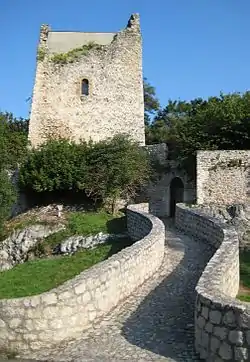 | Tower of Estrada | 13th century | Val de San Vicente | It has wall and chapel. | |
 | Tower of Carrejo | 13th century | Cabezón de la Sal | Well of cultural interest (1984) | Transformed into palace[10] in the 18th century. Today is the Museum of Nature of Cantabria. |
| Tower of Proaño | 13th century | Brotherhood of Campoo de Suso | Well of cultural interest (¿?) | ||
| Tower La Guerra | 13th century | Mazcuerras | Converted into tower-house in the 15th century and later extensively renovated. | ||
| Tower of las Henestrosas | 13th century | Valdeolea | Law 16/1985 | Tower converted then into castle. | |
| Tower of Hojamarta | 13th century | Reocín | Well of cultural interest (1982) | Beside was built the palace of the Bustamante of Quijas. | |
| Tower of Quijas | 13th century | Reocín | |||
| Tower of Velo | Piélagos | Big tower located in the town of Puente Arce. | |||
.jpg.webp) | Tower of Venero | Arnuero | Law 16/1985 | Rebuilt one of its walls that was collapsed. | |
| Tower of Cabrahigo | 14th century | Arnuero | Well of cultural interest (1992) | ||
| Castle of Allendelagua | 14th century | Castro Urdiales | Law 16/1985 | Only remain the startups of the walls. | |
| Tower of Gajano | 14th century | Marina de Cudeyo | Renovated in the 16th century. Has a skylight of 19th.[11] | ||
 | Tower del Condestable | Colindres | Law 16/1985 | A palace was built around the tower thus became an integral part thereof. | |
 | Tower del Infantado | 14th century | Potes | Well of cultural interest (1983) | |
 | Tower of Pero Niño | 14th century | San Felices de Buelna | Well of cultural interest (1983) | |
 | Tower del Merino | 14th century | Santillana del Mar | ||
 | Tower of Ruerrero | 14th century | Valderredible | Well of cultural interest (1992) | Are preserved remains of a moat. It has a cylindrical body as an abutment. |
| Tower of San Martín de Hoyos | 14th century | Valdeolea | Well of cultural interest (¿2004?) | ||
| Tower del Pontón | 14th century | Peñarrubia | The exterior retains full.[12] | ||
| Tower of la Vega | 14th century | Comillas | Ley 16/1985 | Restored. | |
 | Tower of don Beltrán de la Cueva | 15th century (or 16th century) | Santillana del Mar | Well of cultural interest (1981) | Leads attached a palace. |
| Tower of los Velasco | 15th century | Soba | Well of cultural interest (1992) | ||
| Tower of San Martín de la Arena | 15th century | Suances | |||
 | Tower of Don Borja | 15th century | Santillana del Mar | It was probably built on an earlier medieval tower. | |
| Towers of Bores | 15th century | Vega de Liébana | Two similar towers along the way to the neighborhood of Campo (Bores). One of them is fairly well preserved, while the other missing parts and threatens ruin. | ||
| Tower of los Bustamante | 15th century | Campoo de Yuso | Well of cultural interest (1985) | Two nearby similar towers were demolished in the 18th century by threatening ruin. | |
| Tower of Terán | 15th century | Cabuérniga | Restored. | ||
 | Torreón of Cartes | 15th century | Cartes | Well of cultural interest (1985) | |
| Tower of Orejón de la Lama | 15th century | Potes | Located in the neighborhood of Sol. Three levels and relatively good conservation. | ||
| Tower of Villegas | 15th century | Santiurde de Toranzo | Well of cultural interest (1992) | Renaissance fortified house.[13] | |
 | Tower-house of los Alvarado | 16th century | Medio Cudeyo | ||
 | Tower of Cadalso | 16th century | Valderredible | Well of cultural interest (1992) | |
| Tower of los Barreda | 16th century | Suances | Located in Cortiguera, formerly it belonged to a missing fortress. | ||
| Tower of los Ezquerra | 16th century | Soba | |||
| Tower of Gómez de Bárcena | 16th century | San Miguel de Aguayo | Good condition. | ||
| Tower of Hoz | 16th century | Laredo | Law 16/1985 | ||
| Tower-house of los Zorrilla | 16th century | Soba | |||
 | Tower of Pronillo | Santander | Law 16/1985 | Transformed into a palace in the middle of 16th century. | |
| Tower-house of Riva Herrera | 16th century | Marina de Cudeyo | Well of cultural interest (1992) | ||
| Tower-house of Ruiz Bustamante | 17th century | Corvera de Toranzo | Historic and artistic complex (1985) | ||
| Tower of Agüero | 17th century | Corvera de Toranzo | Law 16/1985 | Two-storey building added later. Good condition. | |
| Tower-house of Bustamente Rueda | 17th century | Corvera de Toranzo | Historic and artistic complex (1985) | ||
| Tower of Caviedes | 18th century | Valdáliga | Existed in Caviedes another tower of the 13th century, now defunct. | ||
| Tower of Acereda | Unknown | Santiurde de Toranzo | Totally ruined. It was destroyed in the 15th century by the Marquis of Aguilar de Campoo and Count of Castañeda Garci Fernández Manrique.[13] | ||
| Tower of Barriomonte | Guriezo | Law 16/1985 | |||
| Tower of Berdeja | Peñarrubia | Only remain the foundations.[12] | |||
| Tower of Carasa | Voto | Law 16/1985 | |||
| Tower of Ceballos | Corvera de Toranzo | ||||
| Castle of Cobejo | Molledo | ||||
| Tower of Cos | Mazcuerras | ||||
| Tower of Donadío | Selaya | Medieval tower embedded in a construction of 18th century for conversion into palace. | |||
| Tower of Espina | Ampuero | Law 16/1985 | |||
| Tower of Hoznayo | Entrambasaguas | Law 16/1985 | |||
| Tower of Jado | Argoños | Law 16/1985 | |||
| Tower of Mazcuerras | Mazcuerras | Law 16/1985 | |||
| Tower of Otañes | Castro Urdiales | Ley 16/1985 | Have annexed old buildings in two of its sides, making tower-house. | ||
| Tower of Penagos | Penagos | Law 16/1985 | |||
| Tower of Piedrahita | Peñarrubia | Only preserves some canvases of walls.[12] | |||
| Tower del Rebollar | Arnuero | Law 16/1985 | |||
| Tower of Roiz | Valdáliga | ||||
| Tower of Rubín de Celis | Rionansa | ||||
| Tower of Ruente | Ruente | Converted into hotel.[14] | |||
| Tower of San Miguel de Aguayo | San Miguel de Aguayo | Law 16/1985 | |||
 | Torre de San Telmo | Suances | Law 16/1985 | Only preserved part of two of its walls. | |
| Tower of Secadura | Voto | Law 16/1985 | |||
| Tower of los Señores de Isla | Arnuero | ||||
| Tower of Treto | Bárcena de Cicero | Law 16/1985 | |||
| Tower of Velo | Piélagos | Well of cultural interest (1983) | Medieval tower extended and fenced to make it palace compound during the 16th and 17th centuries, located in Renedo. | ||
| Tower of la Villa | Marina de Cudeyo | Law 16/1985 | |||
 | Tower of Villacarriedo | Villacarriedo | Well of cultural interest | Now part of the Palace of Soñanes, which is building in around him, preserving it. | |
| Tower of Villapresente | Reocín | ||||
| Castle of Villegas | Alfoz de Lloredo | ||||
| Castle of Vispieres | Santillana del Mar | Law 16/1985 | Remains of a fortified tower built on Roman and Castro ruins. | ||
| Tower of Zurita | Piélagos | Law 16/1985 |
References
- Muñoz Jiménez, José Miguel; Towers and castles in medieval Cantabria. Publisher. City Hall of Santander (1993).
- VVAA; Great encyclopedia of Cantabria search. fort house (Ed. Cantabria SA, from 1985 to 2002)
- Díaz Herrera, Carmen; The formation of the feudal society in Cantabria: the organization of the territory in the 9th and 14th centuries, publisher University of Cantabria (1990). ISBN 978-84-87412-15-8
- Bohigas Roldán, Ramón (1999). The organization of space through the medieval archeology. First Meeting of History of Cantabria. Minutes of the meeting in Santander on 16-19 December 1996. Volume 1. University of Cantabria. pp. 417–427. ISBN 8481022179.
- Polo Sanchez, Julio J.; Gil Aguirre, Elena; Gutiérrez Dominguez, César (2003). Medio Cudeyo. Monumental catalog (in Spanish) (First ed.). Santander: Imprenta Cervantina S.L. City Hall of Medio Cudeyo. p. 245. ISBN 84-607-7568-2.
- Eduardo Ruiz de la Riva; House and village in Cantabria: a study of architecture in the valleys of Saja-Nansa, pg 233-234 (Publisher. University of Cantabria, 1991). ISBN 978-84-85429-99-8.
- Ortiz de la Torre, Elías (1927). Civil Architecture. Artistic La Montaña (First ed.). Santander: Talleres Tipográficos J. Martínez. Diputación Provincial. pp. 23–.
- Ortiz de la Torre, Elías (1927). Civil Architecture. Artistic La Montaña (in Spanish) (First ed.). Santander: Talleres Tipográficos J. Martínez. Diputación Provincial. p. 62.
34
- Ruiz de la Riva, Eduardo (1991). House and village in Cantabria. A study of the architecture of the territory in the Valleys of Saja-Nansa. University of Cantabria. p. 233. ISBN 8485429990.
- Ruiz de la Riva, Eduardo (1991). House and village in Cantabria: a study on the architecture of the territory in the Valleys of Saja-Nansa. University of Cantabria. p. 236. ISBN 8485429990.
- El Diario Montañés - Canales; Tower of Gajano m (Last accessed April 15, 2011).
- Cantabria Joven; Archived 2014-08-02 at the Wayback Machine (Last accessed: April 15, 2011).
- El Diario Montañés - channels; Torre de Villegas (Last accessed April 15, 2011).
- Casona La Torre; hotel page Archived 2015-08-12 at the Wayback Machine (Last accessed April 15, 2011).
